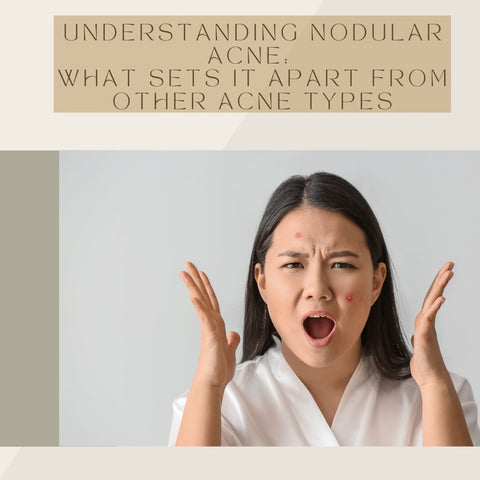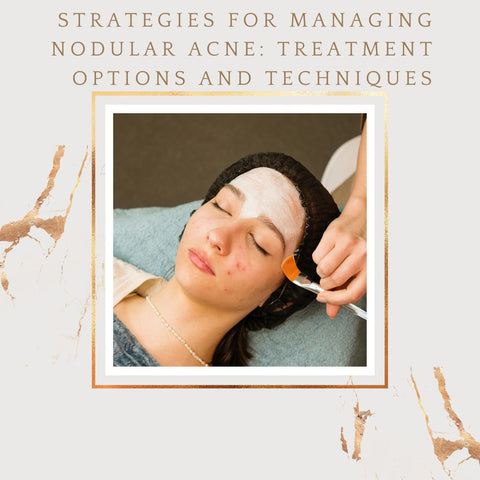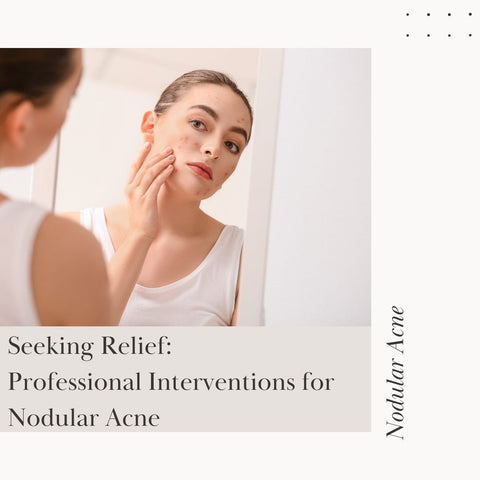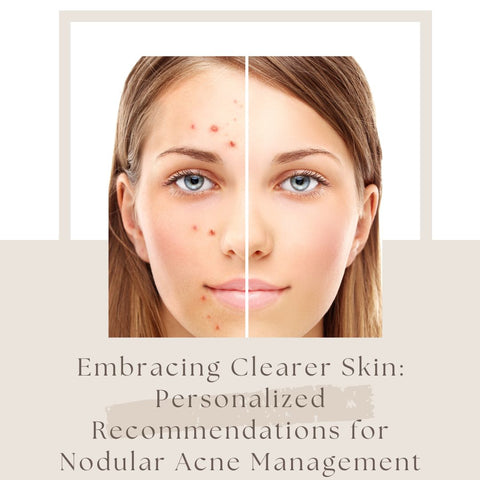Nodular acne can be a difficult skin issue to deal with, but with the correct knowledge, treatment, and prevention techniques, it can be effectively managed. This is a detailed guide to navigating nodular acne.
Understanding Nodular Acne: What Sets It Apart from Other Acne Types

Nodular acne differs from other types of acne in its severity, depth, and possibility of scarring. Some major differences that distinguish nodular acne include the size and depth of lesions, inflammation and pain, persistence, scarring risk, limited response to topical therapies, and impact on quality of life.
Delving into the Depths: The Science Behind Nodular Acne Formation
Understanding the science of nodular acne creation entails investigating the complicated interplay of many elements that influence its growth. This is a more in-depth look at the processes involved, including sebum production, hyperkeratinization, microcomedone creation, bacterial participation, inflammation and immune response, rupture and deep inflammation, scarring, and hormonal influence. Healthcare providers can adapt treatment approaches for individuals with nodular acne by tackling the variables that contribute to its creation, such as sebum production, hyperkeratinization, bacterial overgrowth, and inflammation.
Busting Myths: Common Misconceptions About Nodular Acne
Dispelling myths about nodular acne is critical to promoting accurate understanding and effective management of this difficult skin condition. The following are some common misconceptions about nodular acne:
-
Myth 1: Nodular acne is simply severe acne. Fact: Although nodular acne is a severe form of acne, its depth, inflammation, and potential for scarring set it apart from other forms of acne. If nodular acne is not properly treated, it can result in permanent scarring. Nodular acne is characterised by deep, painful lesions that frequently last for weeks or months.
-
Myth 2: Poor hygiene causes nodular acne. Fact: Improper hygiene is not the only cause of nodular acne. While keeping the skin clean is important for acne prevention, nodular acne is primarily caused by hormonal imbalances, excess sebum production, hyperkeratinization, bacterial overgrowth, and inflammation. Genetics also plays an important role in predisposing people to nodular acne.
-
Myth 3: Nodular acne is simply a cosmetic issue. Fact: Nodular acne can have serious physical and psychological consequences beyond its cosmetic appearance. The pain, inflammation, and scarring associated with nodular acne can have a significant impact on a person's quality of life, causing emotional distress, social withdrawal, and low self-esteem. Furthermore, untreated nodular acne can cause long-term physical scarring and pigmentation changes.
-
Myth 4: Nodular acne is only seen in teenagers. Fact: Although hormonal changes during puberty are the main cause of acne, including nodular acne, it can affect people of all ages. Acne is most commonly linked to adolescence. Nodular acne can appear later in life or last into adulthood. In women, hormonal changes related to menstruation, pregnancy, or menopause are especially common causes of nodular acne. In addition, diseases like PCOS (polycystic ovarian syndrome) can aggravate nodular acne in adults.
-
Myth 5: Acne nodules will disappear on their own. Fact: Nodular acne usually needs treatment to properly manage and prevent long-term complications like scarring, unlike milder forms of acne that may go away on their own. Nodular acne lesions have the potential to worsen, linger, and cause irreversible skin damage if left untreated. Reduce the severity and length of nodular acne outbreaks by seeking treatment as soon as possible.
-
Myth 6: Nodular Acne Is Cleared by Sun Exposure. Fact: Long-term exposure to the sun can exacerbate acne, even though it may momentarily improve the appearance of acne lesions by reducing inflammation and drying out the skin. Sun exposure can exacerbate post-inflammatory hyperpigmentation, thicken the skin, and increase sebum production, all of which can make acne scars more obvious. Furthermore, exposure to the sun without protection can harm the skin and raise the risk of skin cancer.
Nodular Acne vs. Other Forms: Distinguishing Characteristics and Treatment Approaches
Distinguishing between nodular acne and other types of acne is critical in determining the best treatment strategy. Here's a comparison of their characteristics and treatment approaches:
-
Nodular Acne:
-
Large, painful, deep-seated lesions (nodules) that penetrate the deeper layers of the skin. Significant redness, swelling, and tenderness accompany the high level of inflammation. Prolonged duration, with lesions often lasting weeks or months. There is a high risk of scarring if it is not treated promptly and effectively.
-
Isotretinoin (Accutane) is frequently prescribed for severe nodular acne because of its ability to reduce sebum production, prevent clogged pores, and treat inflammation. Intralesional corticosteroid injections are used to quickly relieve inflammation and pain in specific nodules. Laser therapy, chemical peels, and extractions may be suggested to improve the appearance of scars and prevent future breakouts.
2. Papules and Pustules (Inflammatory Acne):
-
Small, red bumps (papules) or pus-filled lesions (pustules) on the skin surface. It is inflammatory but less severe than nodular acne. It can be painful or tender to the touch, but typically less so than nodules. May heal more quickly than nodular lesions but can still lead to scarring if manipulated or untreated.
-
Benzoyl peroxide, retinoids, and topical antibiotics are commonly used to reduce inflammation, unclog pores, and kill acne-causing bacteria. Oral antibiotics such as doxycycline or minocycline may be prescribed for moderate to severe inflammatory acne. A combination of topical and oral medications may be necessary for more stubborn cases.
3. Comedonal Acne:
-
Characterized by non-inflammatory lesions such as blackheads (open comedones) and whiteheads (closed comedones). Minimal redness and inflammation compared to papules, pustules, or nodules. Predominantly located on the forehead, nose, and chin (T-zone).
-
Retinoids work well to encourage exfoliation and inhibit the development of comedones. Examples of these include tretinoin and adapalene. Salicylic acid exfoliates the skin and clears clogged pores. A dermatologist can manually extract comedones to remove stubborn lesions.
4. Hormonal Acne:
-
Acne flare-ups are associated with hormonal fluctuations, particularly in females. It commonly manifests as deep, cystic lesions around the chin and jawline. May coincide with menstrual cycles, pregnancy, or conditions such as polycystic ovary syndrome (PCOS).
-
Hormonal birth control pills containing estrogen and progestin can help regulate hormones and improve acne in women. Spironolactone is an anti-androgen medication that can be effective in reducing hormonal acne by blocking the effects of androgens on the skin. Similar to those used for other forms of acne, topical retinoids and benzoyl peroxide may also be beneficial in managing hormonal acne.
Strategies for Managing Nodular Acne: Treatment Options and Techniques

Managing nodular acne necessitates a holistic approach that addresses the underlying causes of inflammation, decreases the severity of lesions, and reduces the likelihood of scarring. Topical therapies, oral drugs, intralesional corticosteroid injections, procedural treatments, skincare practices, and lifestyle changes are all helpful ways to manage nodular acne. Consulting a dermatologist is vital for building a personalised treatment plan and tracking progress towards clearer, healthier skin while minimising any side effects.
Targeted Treatments: Tailoring Solutions to Tackle Nodular Acne
Treatments for nodular acne require a multifaceted approach that addresses the underlying causes of inflammation, reduces the severity of lesions, and prevents scarring. Here's how you can tailor solutions to effectively treat nodular acne:
-
Comprehensive Evaluation: Consult a dermatologist for professional advice on the severity of your nodular acne, potential triggers, and personalised treatment options. Determine your skin type, sensitivity, and any other skin conditions that may impact treatment options.
-
Targeted Treatment Options: Isotretinoin may be used to treat severe nodular acne that has not responded to other treatments. It addresses a variety of acne-causing factors, including excessive sebum production, inflammation, and abnormal skin cell shedding. If isotretinoin is ineffective, oral antibiotics like doxycycline or minocycline may be prescribed to reduce inflammation and bacterial overgrowth. Prescription-strength retinoid creams such as tretinoin or adapalene can help to unclog pores, reduce inflammation, and prevent new acne lesions from developing.
-
Procedural Interventions: Corticosteroid injections should be considered for large, painful nodules to quickly reduce inflammation and discomfort. To target acne-causing bacteria, reduce inflammation, and improve scar appearance, consider laser treatments like pulsed dye laser or fractional laser therapy.
-
Combination Therapies: Combine topical retinoids or benzoyl peroxide with oral antibiotics for a synergistic effect in reducing inflammation and controlling bacterial overgrowth. For women with hormonal acne, combining hormonal contraceptives with topical treatments like retinoids or benzoyl peroxide may help regulate hormones and improve acne.
-
Skincare Regimen: Choose skincare products labeled as non-comedogenic to avoid clogging pores and aggravating acne. Use a mild cleanser to wash your face twice daily and remove excess oil, dirt, and impurities without stripping the skin.
-
Lifestyle Modifications: Consider dietary modifications such as reducing the intake of high-glycemic foods and dairy products, which may exacerbate acne in some individuals. Practice stress-reducing techniques like meditation, yoga, or deep breathing exercises to help manage stress levels, which can influence acne flare-ups.
-
Regular Follow-Up: Schedule regular follow-up appointments with your dermatologist to monitor treatment progress, adjust medications if necessary, and address any concerns or side effects. Once acne is under control, maintain a consistent skincare routine and continue with any prescribed treatments to prevent future breakouts and minimize the risk of scarring.
Skincare for Severe Acne: Building a Routine to Combat Nodular Breakouts
Building a skincare routine for severe nodular acne necessitates careful selection of products and techniques that target inflammation, unclog pores, and promote healing while avoiding exacerbating the condition. To effectively combat nodular breakouts, follow this tailored skincare routine:
Morning Routine:
- To wash your face, apply a mild, non-comedogenic cleanser. Look for products with salicylic acid or benzoyl peroxide to help unclog pores and reduce bacteria.
- Use a prescription-strength retinoid cream or gel on clean, dry skin. Retinoids help to increase skin cell turnover, unclog pores, and reduce inflammation. Follow your dermatologist's advice regarding frequency and application.
- To hydrate the skin without clogging pores, apply an oil-free, non-comedogenic moisturiser. Look for ingredients that help maintain skin barrier function, such as hyaluronic acid or ceramides.
- Apply a broad-spectrum sunscreen with an SPF of 30 or higher every morning, even on cloudy days. To avoid exacerbating acne, choose oil-free or non-comedogenic formulations.
Evening Routine:
-
Use an oil-based cleanser to remove makeup, sunscreen, and excess oil. Follow with a gentle foaming or gel cleanser to thoroughly cleanse the skin.
-
Following cleansing, use any prescribed topical treatments, such as retinoids or benzoyl peroxide. Allow the treatment to absorb completely before moving on to the next step.
-
For individual nodules, apply a small amount of benzoyl peroxide or salicylic acid spot treatment to the affected areas. Avoid using too much product, as it can cause irritation.
-
Reapply a lightweight, non-comedogenic moisturiser to keep the skin hydrated and prevent dryness. To reduce inflammation, choose a product that contains soothing ingredients such as niacinamide or aloe vera.
-
If your skin is particularly dry or sensitive, apply a thin layer of occlusive moisturiser or petroleum jelly to lock in moisture and form a protective barrier overnight.
Weekly Treatments:
- Incorporate a gentle exfoliating treatment once or twice a week to help remove dead skin cells and unclog pores. Avoid harsh physical scrubs, which can irritate inflamed skin. Instead, opt for chemical exfoliants containing ingredients like salicylic acid or alpha hydroxy acids (AHAs).
- Use a clay mask or sulfur mask once a week to help absorb excess oil, reduce inflammation, and detoxify the skin. Look for masks specifically formulated for acne-prone skin.
Lifestyle Changes to Prevent Nodular Acne: Habits That Can Help Keep Breakouts at Bay
In addition to cosmetics and medical treatments, making lifestyle changes can help avoid nodular acne breakouts and improve overall skin health. Maintaining a healthy diet, practicing good skincare habits, managing stress, exercising regularly, avoiding touching your face, limiting sun exposure, avoiding smoking and excessive alcohol consumption, and practicing hygiene practices are all good habits to incorporate into your daily routine to prevent breakouts.
Seeking Relief: Professional Interventions for Nodular Acne

Professional treatment for nodular acne can provide effective relief and help manage the condition more efficiently. Here are some professional treatments commonly used for nodular acne.
-
Isotretinoin (Accutane): Isotretinoin is a powerful oral medication derived from vitamin A. It is reserved for severe nodular acne that has proven resistant to other treatments. Isotretinoin lowers sebum production, prevents clogged pores, and has anti-inflammatory properties. Isotretinoin can cause significant and long-term improvement in nodular acne by reducing the frequency and severity of breakouts and lowering the risk of scarring. Isotretinoin has potential side effects and should be closely monitored by a dermatologist. If taken while pregnant, it may cause dry skin, increased sun sensitivity, and birth defects.
-
Oral Antibiotics: Doxycycline, minocycline, and tetracycline are common oral antibiotics used to treat nodular acne and reduce inflammation and bacterial overgrowth. Antibiotics help kill acne-causing bacteria and reduce the inflammatory response in the skin. Oral antibiotics can help improve the appearance of nodular acne lesions and reduce pain and inflammation. Long-term use of antibiotics can lead to antibiotic resistance and may not be suitable for everyone. They are often used in combination with other treatments for maximum efficacy.
-
Intralesional Corticosteroid Injections: Dermatologists may administer corticosteroid injections directly into large, painful nodules to rapidly reduce inflammation and relieve discomfort. Corticosteroids help suppress the inflammatory response in the skin, leading to a reduction in swelling and pain. Intralesional corticosteroid injections provide rapid relief for individual nodules and can help improve the overall appearance of nodular acne. This treatment is typically reserved for large, persistent nodules and may cause temporary skin thinning or lightening at the injection site.
-
Procedural Treatments: Chemical peels containing ingredients like salicylic acid or glycolic acid can help exfoliate the skin, unclog pores, and improve the appearance of acne scars. Various laser treatments, such as pulsed dye laser or fractional laser therapy, can target acne-causing bacteria, reduce inflammation, and stimulate collagen production to improve the overall texture and appearance of the skin. Dermatologists can perform manual extraction of large, stubborn nodules to remove trapped sebum, bacteria, and debris and promote healing.
Medications and Procedures: Options for Managing Severe Nodular Acne
Severe nodular acne is frequently treated with a combination of medications and procedures to effectively control inflammation, reduce the severity of lesions, and prevent scarring. Here are several options for treating severe nodular acne:
Medications:
-
Isotretinoin (Accutane): Isotretinoin is a potent oral medication derived from vitamin A. It reduces sebum production, prevents clogged pores, and has anti-inflammatory effects. Isotretinoin is typically reserved for severe nodular acne that is resistant to other treatments. Requires close monitoring by a dermatologist due to potential side effects, including dryness, increased sun sensitivity, and birth defects if taken during pregnancy.
-
Oral Antibiotics: Oral antibiotics such as doxycycline, minocycline, or tetracycline may be prescribed to reduce inflammation and control bacterial overgrowth. Antibiotics help kill acne-causing bacteria and reduce the inflammatory response in the skin. Long-term use of antibiotics can lead to antibiotic resistance and may not be suitable for everyone.
-
Hormonal Therapy (for females): Oral contraceptives containing estrogen and progestin can help regulate hormones and improve acne in women. Anti-androgen medications like spironolactone may also be prescribed to block the effects of androgens on the skin.
Procedures:
-
Intralesional Corticosteroid Injections: Dermatologists may administer corticosteroid injections directly into large, painful nodules to rapidly reduce inflammation and relieve discomfort. Corticosteroids help suppress the inflammatory response in the skin, leading to a reduction in swelling and pain. This treatment is typically reserved for large, persistent nodules and may cause temporary skin thinning or lightening at the injection site.
-
Procedural Treatments: Chemical peels containing ingredients like salicylic acid or glycolic acid can help exfoliate the skin, unclog pores, and improve the appearance of acne scars. Various laser treatments, such as pulsed dye laser or fractional laser therapy, can target acne-causing bacteria, reduce inflammation, and stimulate collagen production to improve the overall texture and appearance of the skin. Dermatologists can perform manual extraction of large, stubborn nodules to remove trapped sebum, bacteria, and debris and promote healing.
Safety Considerations: What to Know Before Pursuing Aggressive Treatments
Before pursuing aggressive treatments for severe nodular acne, it is critical to consider several safety factors and potential risks of these interventions. Here's what you should know:
1. Potential Side Effects and Risks:
- Isotretinoin has several side effects, including dry skin, lips, and eyes, nosebleeds, muscle or joint pain, and increased sensitivity to sunlight.
- If taken while pregnant, more serious side effects may include mood swings, depression, suicidal thoughts, and birth defects.
- Regular monitoring by a healthcare provider is critical for managing side effects and ensuring patient safety.
- Long-term use of oral antibiotics can result in antibiotic resistance, gastrointestinal upset, photosensitivity, and yeast infections.
- To reduce risks and improve outcomes, adverse effects must be monitored and treatment efficacy evaluated regularly.
- Injections can cause temporary skin thinning, lightening, or atrophy near the injection site.
-
The risk of infection or allergic reaction exists, but it is rare when performed by a
2. Pregnancy and Contraindications:
-
Isotretinoin is highly teratogenic and must not be used during pregnancy or in women planning to become pregnant.
-
Female patients of childbearing age must use two forms of contraception and undergo regular pregnancy testing while taking isotretinoin.
-
Some oral antibiotics may interfere with hormonal contraceptives, reducing their effectiveness. Alternative contraception methods may be necessary during antibiotic treatment.
3. Patient Monitoring and Follow-Up:
-
Patients undergoing aggressive acne treatments require close monitoring by a healthcare provider to assess treatment response, manage side effects, and adjust medications as needed.
-
Follow-up appointments allow for evaluation of treatment efficacy, monitoring for adverse effects, and addressing any concerns or questions.
4. Precautions and Preparations:
-
Many acne medications and treatments can increase skin sensitivity to sunlight. Patients should use broad-spectrum sunscreen with SPF 30 or higher and avoid prolonged sun exposure.
-
Some medications, such as isotretinoin, can cause dryness and dehydration. Patients should drink plenty of water to stay hydrated and moisturize the skin as needed.
5. Individualized Treatment Plans:
-
Treatment plans should be tailored to each patient's unique needs, considering factors such as the severity of acne, skin type, medical history, and lifestyle.
-
Patients should communicate openly with their healthcare providers about their concerns, preferences, and treatment goals.
Painful Pimples: Tips for Managing Discomfort Associated with Nodular Acne
Managing the discomfort caused by nodular acne can be difficult, but there are various tactics you can use to relieve pain and inflammation. Hands off, cool compresses, topical treatments, oral pain relief, soft, non-irritating skincare, avoiding irritants, seeking professional advice, and being patient and persistent while dealing with painful pimples caused by nodular acne. By following these guidelines, you can alleviate the discomfort associated with painful pimples produced by nodular acne and encourage recovery. If the discomfort persists or worsens, or you have severe acne symptoms, see a dermatologist for personalised advice and treatment options.
Embracing Clearer Skin: Personalized Recommendations for Nodular Acne Management

Embracing cleaner skin while dealing with nodular acne necessitates a tailored approach that takes into account individual needs, concerns, and treatment preferences. Consultation with a dermatologist, medication options, procedural treatments, skincare routine, lifestyle modifications, and regular follow-up are some of the personalised recommendations for effectively controlling nodular acne. Working together with a dermatologist and following personalised advice will help you control nodular acne and achieve cleaner, healthier skin over time. Remember that consistency and patience are essential, and it may take weeks or months to see meaningful progress.
















